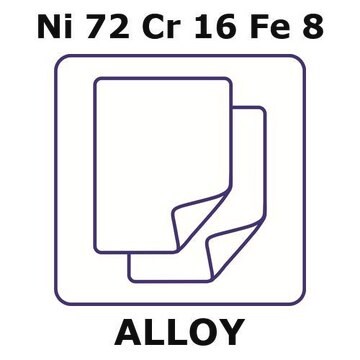GF34073344
Molybdenum
rod, 200mm, diameter 10.0mm, centerless ground, 99.9%
Sinonimo/i:
Molybdenum, MO007920
Autenticatiper visualizzare i prezzi riservati alla tua organizzazione & contrattuali
About This Item
Formula empirica (notazione di Hill):
Mo
Numero CAS:
Peso molecolare:
95.94
Numero MDL:
Codice UNSPSC:
12141727
ID PubChem:
NACRES:
NA.23
Prodotti consigliati
Saggio
99.90%
Stato
rod
Produttore/marchio commerciale
Goodfellow 340-733-44
Resistività
5.0 μΩ-cm, 20°C
L × diam.
200 mm × 10.0 mm
P. ebollizione
4612 °C (lit.)
Punto di fusione
2617 °C (lit.)
Densità
10.3 g/mL at 25 °C (lit.)
Stringa SMILE
[Mo]
InChI
1S/Mo
ZOKXTWBITQBERF-UHFFFAOYSA-N
Descrizione generale
For updated SDS information please visit www.goodfellow.com.
Note legali
Product of Goodfellow
Scegli una delle versioni più recenti:
Certificati d'analisi (COA)
Lot/Batch Number
It looks like we've run into a problem, but you can still download Certificates of Analysis from our Documenti section.
Se ti serve aiuto, non esitare a contattarci Servizio Clienti
Possiedi già questo prodotto?
I documenti relativi ai prodotti acquistati recentemente sono disponibili nell’Archivio dei documenti.
Bernd Masepohl et al.
Advances in experimental medicine and biology, 675, 49-70 (2010-06-10)
The vast majority of the purple nonsulfur photosynthetic bacteria are diazotrophs, but the details of the complex regulation of the nitrogen fixation process are well understood only for a few species. Here we review what is known of the well-studied
Ralf R Mendel et al.
Biochimica et biophysica acta, 1823(9), 1568-1579 (2012-03-01)
The transition element molybdenum (Mo) needs to be complexed by a special cofactor in order to gain catalytic activity. With the exception of bacterial Mo-nitrogenase, where Mo is a constituent of the FeMo-cofactor, Mo is bound to a pterin, thus
Angel Llamas et al.
Metallomics : integrated biometal science, 3(6), 578-590 (2011-05-31)
Molybdenum (Mo) is a very scarce element whose function is fundamental in living beings within the active site of Mo-oxidoreductases, playing key roles in the metabolism of N, S, purines, hormone biosynthesis, transformation of drugs and xenobiotics, etc. In eukaryotes
Yilin Hu et al.
Microbiology and molecular biology reviews : MMBR, 75(4), 664-677 (2011-12-01)
Nitrogenase catalyzes a key step in the global nitrogen cycle, the nucleotide-dependent reduction of atmospheric dinitrogen to bioavailable ammonia. There is a substantial amount of interest in elucidating the biosynthetic mechanisms of the FeMoco and the P-cluster of nitrogenase, because
Manuel Tejada-Jiménez et al.
Metallomics : integrated biometal science, 5(9), 1191-1203 (2013-06-27)
The viability of plants relies on molybdenum, which after binding to the organic moiety of molybdopterin forms the molybdenum cofactor (Moco) and acquires remarkable redox properties. Moco is in the active site of critical molybdoenzymes, which use to work as
Il team dei nostri ricercatori vanta grande esperienza in tutte le aree della ricerca quali Life Science, scienza dei materiali, sintesi chimica, cromatografia, discipline analitiche, ecc..
Contatta l'Assistenza Tecnica.






